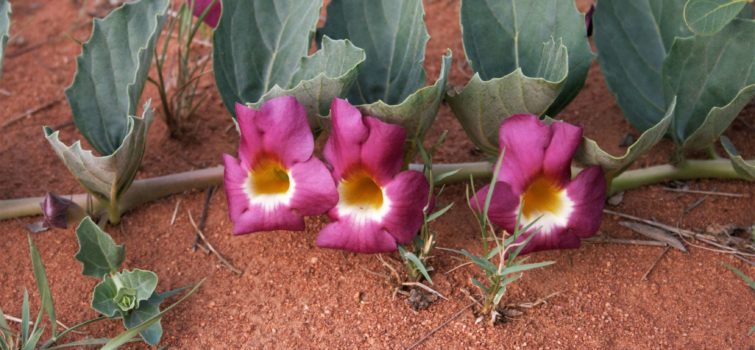Nature’s Medicine Chest
In October 2018, we were in northern Kruger National Park when I was reminded about the trade in traditional medicinal products in South Africa. We were in the farthest northern part of the Kruger National Park driving along the Levubu River. We passed a common cluster fig or sycamore fig tree with a neat rectangular section of bark missing from near the base of the tree.
I recognised why this was so immediately. This 23,000ha section of the Kruger National Park was a land claim that was successfully handed back to the Makuleke Community in 1998, having been removed from their possession in 1969. This area now falls under their care in a joint conservation venture with SANPARKS. The section of bark missing from the fig tree was unmistakably removed by a traditional healer in the area, most likely given access through the community.
Why? Because the bark of this fig tree is used to treat chest pains, stomach concerns, and gland ailments.
Seeing evidence of this was reminiscent of the time we spent in the rural community rangelands near the Wits Rural Facility, a rural campus of the University of the Witwatersrand. We had met with and interviewed traditional healers in the area as part of a larger research programme in conserving natural resources outside of conservation areas. It reminded me that traditional medicinal uses of plants are still very important in both rural and urban communities in South Africa today.
There is evidence to show that traditional medicines have been used for centuries and continue to be used today to fulfil health care needs.
- The earliest record of plants used for medicinal purposes is evident in Ancient Egypt on the Ebers papirus, a medical scroll that dates to around 1500BC [5].
- In Hindu cultures, there are records dating back close to 1500BC in the Rig Veda, a poem referring to medicinal information on plants [5].
- In South Africa alone, close to 80% of the population use traditional medicines to meet their primary health care needs [1].
Our rich biodiversity hosts close to 30,000 flowering species of plants and even with our strong history of traditional healing, a small percentage of these are used for their medicinal properties. Approximately 350 – 700 indigenous species are commonly known to be used throughout South Africa in traditional healing, although some research suggests up to 10% of our species are used [3].
Very few South African species have been explored to their full potential in providing medicinal uses both for local use and for commercial value [1]. There are a few renowned medicinal plants that enjoy international acclaim such as rooibos, which is used to contribute towards the local economy. In Africa, rooibos is referred to as ‘long-life tea’, and its medicinal properties are widely renowned.
Although there are various forms of rooibos, it is an endemic species to the South African fynbos where its uses were first recognised by the Hottentot people.
The Importance Of Traditional Healers
Traditional healers are an important part of today’s society. In the late 1990s in sub-Saharan Africa, the ratio of traditional healers to the overall population was 1:500. Western-trained medical practitioners in the population were at a ratio of 1:40000. In South Africa alone there were estimated to be 200,000 traditional healers with 25,000 registered western-trained doctors. Centuries of sustainable use of medicinal plants was facilitated by several indirect control methods and intentional practices [4].
Changes in the traditional healing practice caused some of these controls to be lost. The intensive harvesting of medicinal plants poses a real threat to the diversity of an area. There is a risk of over exploitation as the demand and commercial value increases. Without the traditional controls and ancestral limitations, this industry will be lost. The value of traditional medicines has grown as our population has grown, increasing the demand. Traditional healers have stringent traditional values which include taboos, superstitions, and cultural beliefs regarding medicinal plants. These contribute to the conservation of these plant species.
Examples of these controls include:
- Only collecting plant material that has been ordained by ancestors and after performing certain rituals
- Where roots are collected and used, no more than two roots are permitted by cultural tradition
- Restrictions to harvest times to limit the impact of growth season and seed production
- Bark is harvested from the east and west sides of trees only (particularly for bark used for kidney ailments, the harvesting on E and W sides resembles the kidneys). This prevents ring barking the tree
- Tools used for collecting material are limited to a wooden stick with a point or a small hand axe to limit the amounts taken and damage done to the plant
Traditional healers collected and practised these traditions of harvesting, where now commercial/illegal harvesters do not observe these restrictions or controls. This is having devastating impacts on the biodiversity and availability of medicinal plants. Research shows that the collection of medicinal plants is made up primarily of – bark (27%), Roots (27%), whole plant (13%), and bulbs (13%). This would inevitably kill any plant collected and so harvesting is only done once unless strict controls are in place.
I remember when completing the research work with the Wits Rural Facility, we were informed that the community recognised traditional healers. They are called upon by ancestors to practice these traditions and are held accountable by the community elders and the community as a whole to ensure they adhere to these controls. Those who are following tradition and make use of these controls are losing out to the commercial harvesting and overexploitation. The reason to enforce these controls has been lost and the authentic traditional healers are being overshadowed by these, fly-by-night traders.
The estimated total medicinal plant produce trade in South Africa is worth R2.9 billion or $414 million per annum. This equates to 35,000 – 70,000 tonnes of plant material used annually by approximately 27 million of our people.
The Devil Is In The Detail
It is clear, the use of plants has significant social and economic value, but the real interest for me really lies in the older traditional uses of these plants and how we are quite literally living in nature’s medicine chest.
Within the area that is Makweti Safari Lodge, I was surprised to see just how many species of indigenous plants were right here in the camp that are still used for their medicinal properties. The more I looked, the more species I found. The cultural beliefs, uses, stigmas, and medicinal properties all over southern Africa are unique and this is where the real fascination lies.
The Devils Claw
Harpagophytum procumbens (Tswana/ Pedi – sengaparile)
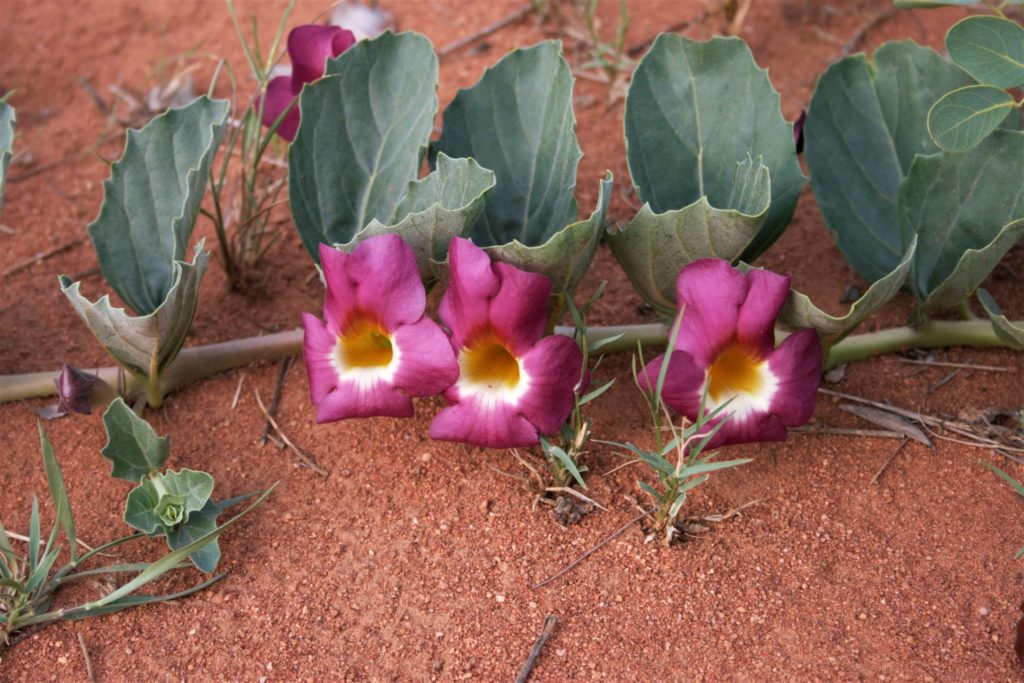
Devil’s Claw
This perennial herb (pictured above) is native to South Africa, Namibia, and Botswana. Early farmers believed this plant to be an irritant and a limitation to beef farming in areas where it grows. The fruit is a multi-clawed capsule with sharp protrusions that lodge in the hooves of cattle, debilitating them and difficult to remove. Locally, the root is primarily used, which is a large water-storing tuber enabling the plant to survive in the dry sub-Saharan environment. Extracts from the root are used to treat rheumatism, arthritis, and diabetes. This plant has been used extensively and is commercially available in gel form, as capsules or in powder form. Clinical studies have indicated its effectiveness in acute low back pain [9].
It is often found growing next to roads where the soil conditions are optimal and where rain runoff from the road provides a steady supply of water. It prefers disturbed areas and is found around drinking pans on the reserve and close to areas where farming activity took place many years back.
This is not to be confused with, and easily and often is, with the devil’s thorn (pictured below). This similar looking plant has smaller leaves and flowers, the fruit a small flat disc with hornlike protrusions on the top and bottom. It is not used medicinally, but when its wet, the leaves release a mucus, which is used as an effective soap and shampoo.
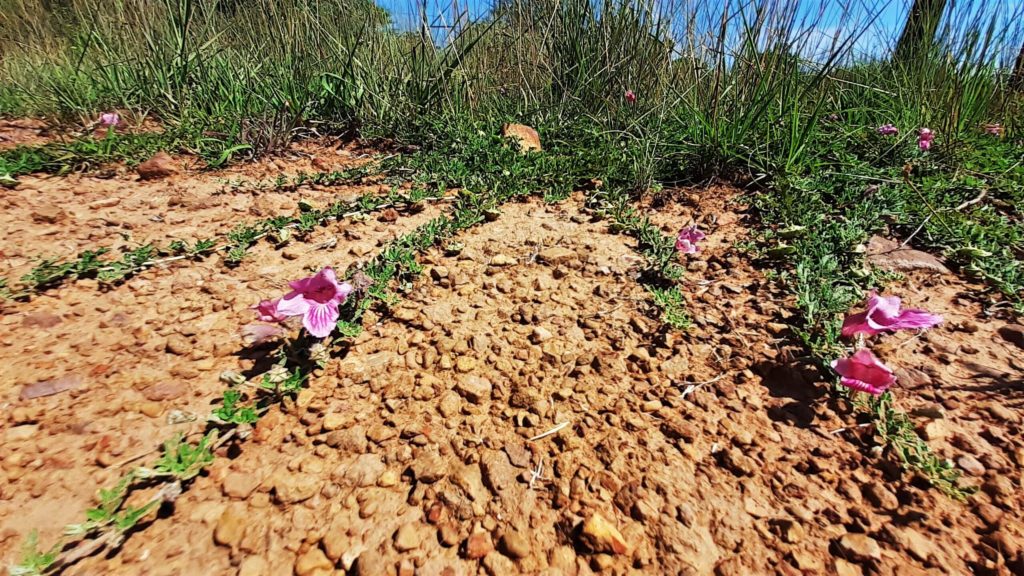
Devil’s Thorn
Wild Fever Tea
Lippia javanicum (Pedi – musukudu, Tswana – musukujane, Shangaan – musukjwane, Xhosa – Inzinzinaba)
Widespread in southern African, this plant is commonly seen and smelled herb all over the reserve. It dominates the areas along the Taaibos River at iBhubesi plains and is growing along the paths in the camp. Its pungent aromatic herbal scent, that of mint mixed with sage, is often picked up whilst driving around the reserve as the vehicle disturbs it. Locally known as musukudu, it is used extensively for treating cold and flu symptoms as well as mild throat infections.
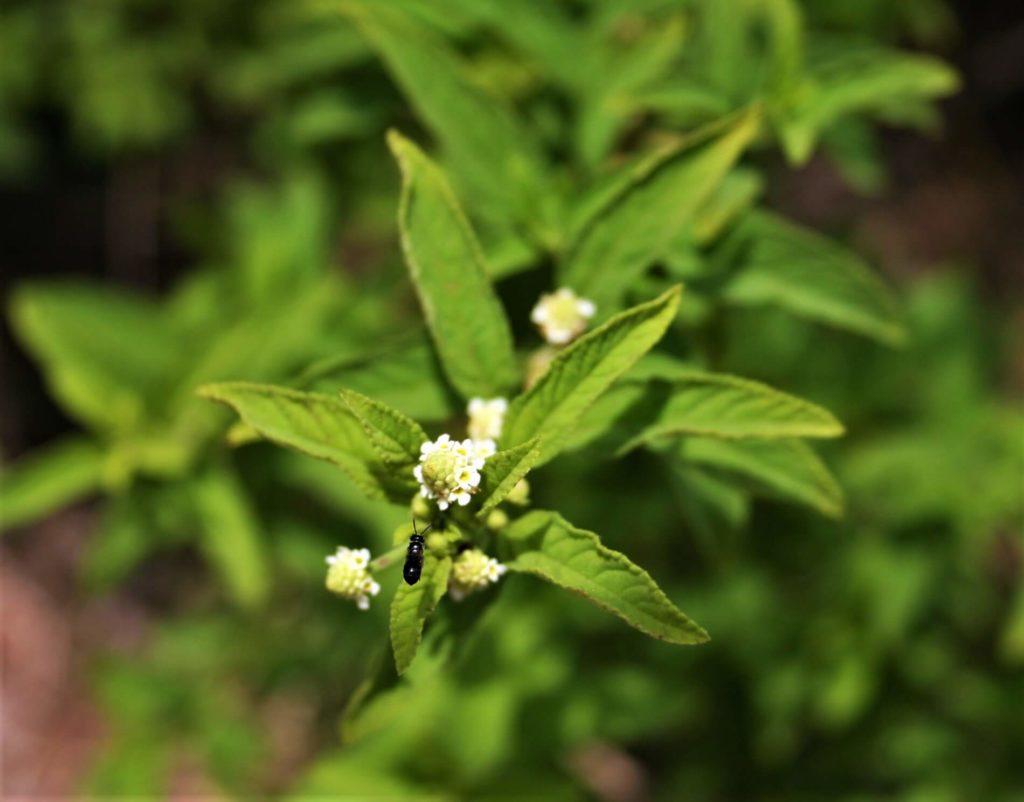
Wild Fever Tea Flower
The leaves steeped in boiled water are drunk as herbal tea, giving soothing effects to these mild symptoms. In the Eastern Cape the Xhosa cultures use it similarly, but decoctions from the leaves are also used to treat chicken pox [2]. When in flower it is beautiful with its vibrant lime green leaves contrasting the small white flowers. In winter it dies back completely to a dried mass of twigs, only to be revived again by the first summer rains.
The oils of this plant have been investigated commercially to be used as a repellent specifically to control bark beetles of the genus Ips [10].
Elands Bean
Elephantorrizha elephantina (Venda – mositsana, Pedi – mosehlana, Xhosa – intolwane)
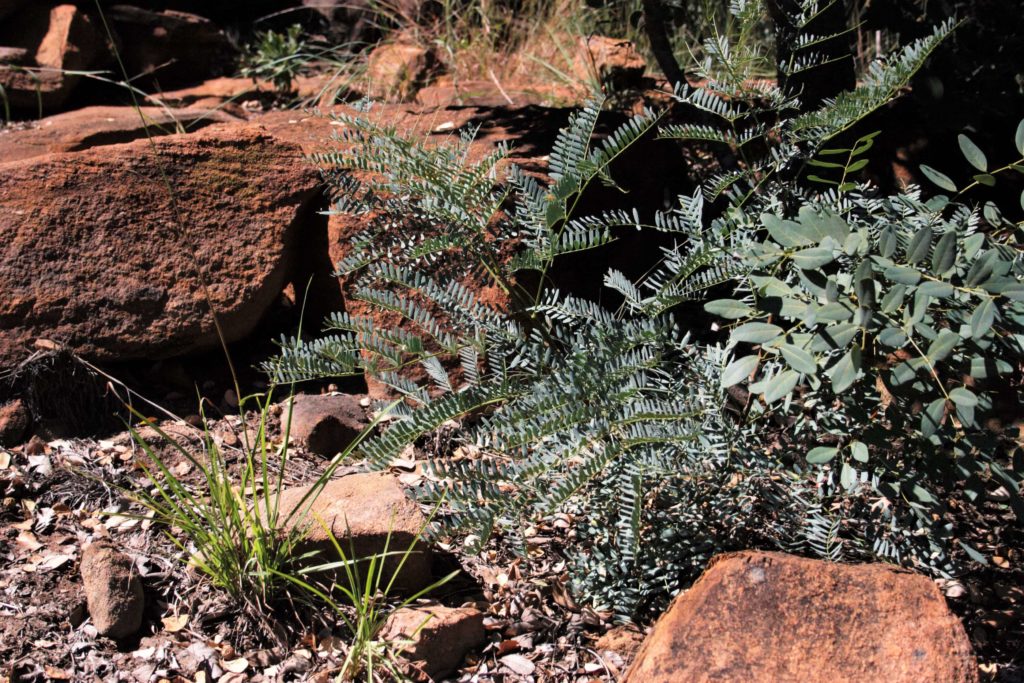
Eland’s Bean
This ‘underground tree’ (pictured above) is a common species on the reserve. It has thick underground stems referred to as rhizomes which can be 8m long. The thin flowering and fruiting branches reach 1m in height. This plant often ‘greens’ up as the first colour in Spring, but is left untouched by most herbivore species, including the elephant. Later in the season I have seen elephant feeding minimally on it. There are 2 species in the area of the genus Elephantorrizha, E.burkei being the second. This species is not used as extensively for its medicinal properties but more so for its uses in tanning leather.
In the northern parts of the country the root extracts are used to treat female fertility. In the Xhosa communities of the Eastern Cape the rhizomes are used to treat high blood pressure and rashes as well as to purify the blood [3].
Waterberry
Syzgium cordatum (Venda – mutu, Xhosa – umjomi, umswi)
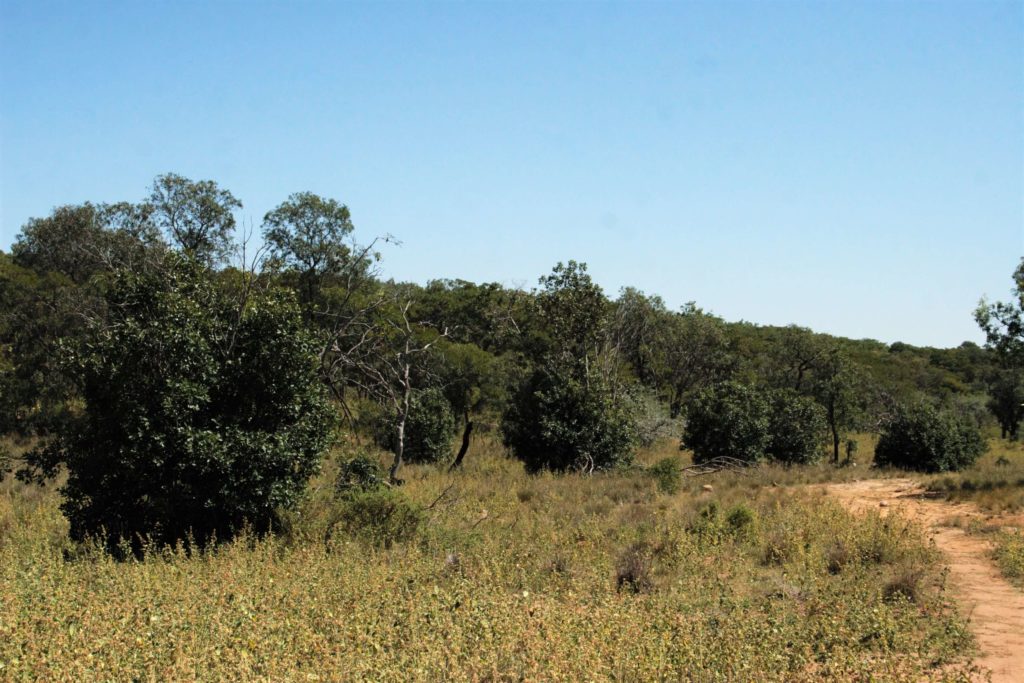
Waterberry Trees
This medium-sized tree of up to 15m is a common site on Welgevonden Game Reserve. These beautiful evergreen trees line the pass that leads down the valley towards Makweti’s access road. They are seen along the watercourses on the reserve forming riverine thickets. The fruit when ripe is a small raisin-sized berry that is a dark red wine colour. It is nutritious to eat although tasteless, being eaten by many species of animals and birds.
The Xhosa cultures use the bark to treat inflammation and poor skin conditions. The wood, when burnt, is aromatic and is used to treat milk gourds. Locally the bark is used to treat stomach problems and diarrhoea. It is also used as a dye and gives a reddish-brown colour. The fruit is used as a purple dye.
The wood is durable and used in construction for rafters and beams and is particularly good for boat building [10].
The commonly used aromatic spice used in cuisines around the world, cloves, is from a sister species of this plant S. aromaticum. Cloves are the dried flower buds of this tree species.
Cork Bush
Mundulea sericea (N.Sotho – moshisane)
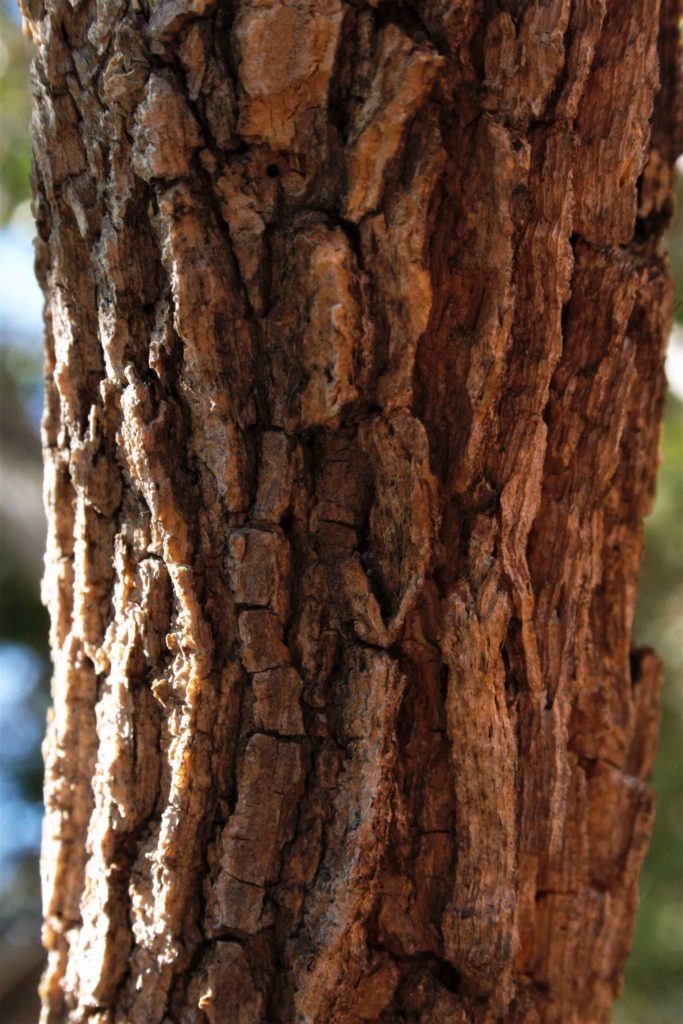
Cork Bush Bark
This particularly toxic species of plant is found in rocky areas on the reserve. It is a small semi-deciduous tree that has a thick, corky bark from whence its name derives. The flowers are pea-like pale to dark purple. There is a beautiful specimen growing outside the entrance to the main lodge. It has been damaged by elephants before but has recovered well. There are also 2 specimens of this species seen close to the road en route to the main gate, and each year both flower spectacularly.
Locally known as moshisane, this species is widely used in many cultures. Herbivores feed on its leaves, although toxic, and I have witnessed giraffe and kudu using this species as suitable browsing matter. In Zulu cultures, the bark is used as an emetic (to induce vomiting) when poisoning is suspected. The bark and seeds contain rotenone, which is highly toxic to fish and insects. Handfuls were thrown into water ponds to catch fish, poisoning them. Whether or not these dead fish were safe to consume is unknown, and some people have been mildly ill after eating fish caught in this manner.
In Eastern Africa, it is believed that the toxin is strong enough to kill small crocodiles. It is also recorded that strips of bark tied around the ankles of cattle would protect them from crocodiles when crossing rivers or shallow streams. The strength of this toxin in this species varies geographically. In some areas, poisons are made for arrows using decoctions of the bark and leaves and have also been used in poisons to induce suicide in some African cultures.
In the Venda cultures, the powdered root is used to treat the wife of a newly married couple, improving her fertility and strength to bear children. In this ritual, the couple is tied together with their backs to the tree.
Wild Cannabis
Leonotis leonurus (Zulu – imunyane, Xhosa – imvovo)
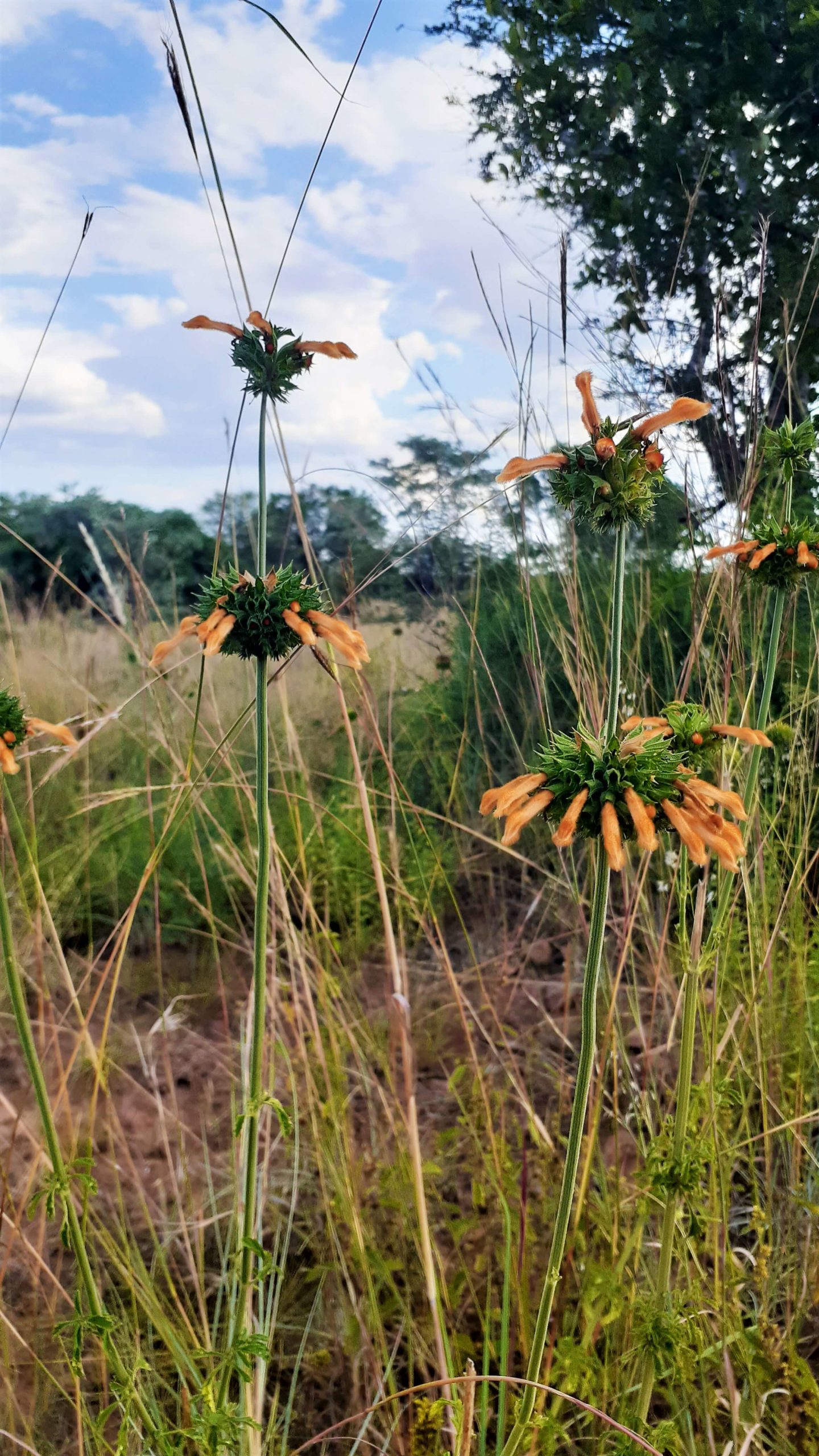
Wild Cannabis
This strange-looking but somewhat beautiful plant has been used extensively in southern African cultures. The leaves have been smoked for epilepsy with decoctions of the stem, flowers and leaves taken for headaches. Leaf infusions were also used to treat, colds, coughs and asthma. This plant has similar diterpenoid lactones as the European white horehound, which is used in cough medicines [10]. Early uses of the plants were as a type of chewing tobacco or as a tobacco replacement. In Zimbabwe, the sister species of this is used in infusions to drive away evil spirits [10].
It is localised but common on the reserve and in Summer, is easily identified by its standout shape and the beautiful clusters of orange flowers that form in sections up the stem.
Bible Flower or Sore-eye Flower
Ammocharis coranica (N.Sotho – boka, Zulu – isidiya)
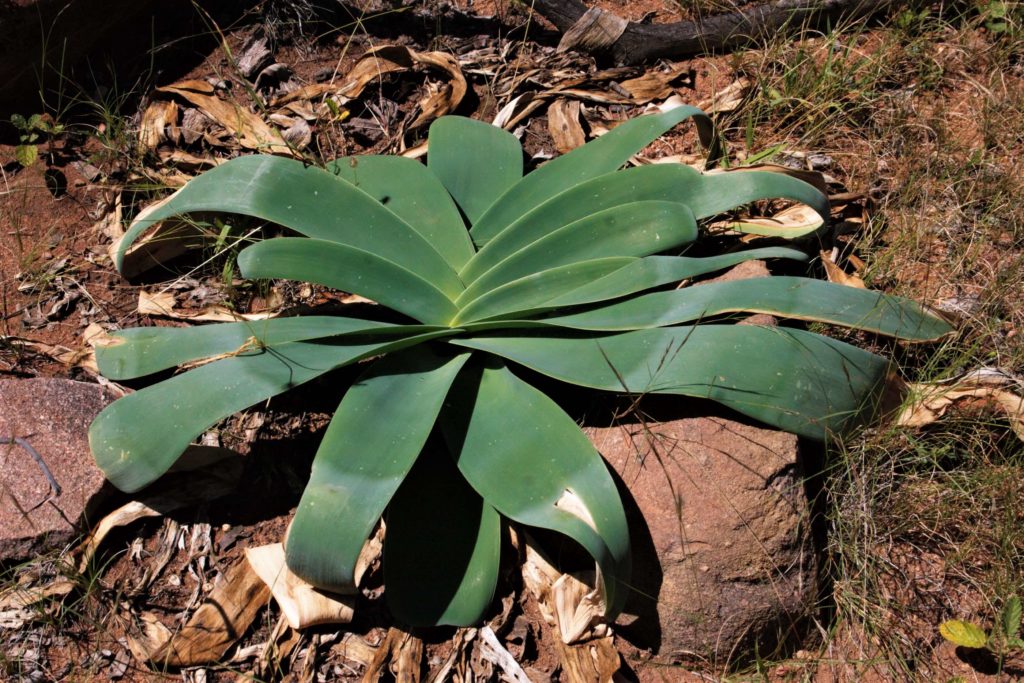
Bible Flower
The vernacular name refers to the way the leaves lay open along the ground as if someone had dropped their bible and it had landed with its pages open. Belonging to the Amaryllis family, it produces a beautiful flower or inflorescence that is unmistakable. It is highly toxic and has varied uses as a result. The leaves conceal a large bulb like an onion, which is ‘shaved’ using a small stick. The Zulu cultures use extracts of the bulb to treat mental illness brought about by witchcraft. The cooked bulb, forming a paste, is used to seal and repair clay pots. In studies in the Limpopo province, bulb decoctions are also used to treat male infertility.
This plant is seen growing in camp along the pathway to the main lodge from the Indaba. It flowers early in November/December. For the remainder of the year, it appears as the ‘open book’ of leaves.
Bushman’s Poison Bulb
Boophane disticha (Tswana – leshoma, Xhosa – incwadi)
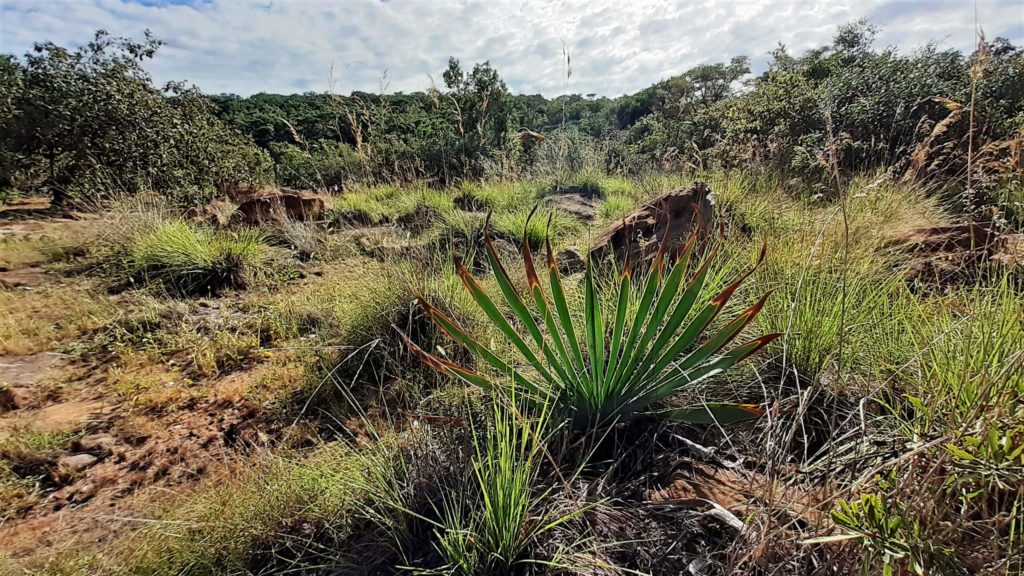
Bushmans Poison Bulb
This bulbous plant has a very distinctive fan shape from its strap-like leaves [9]. The bulb is partly exposed above the ground showing its numerous papery scales. There are 3 beautiful plants growing in the camp, close to the office and along the path to rooms 4 and 5. The dried outer scales of the bulb are applied to boils and wounds, when mixed with milk applied to septic wounds. Leaf decoctions are used to treat headaches and abdominal pains. The Hottentots had an old belief that sleeping on a mattress of the scales would relieve hysteria and insomnia.
The San used higher doses of the scale decoctions to induce hallucinations and in divination in their trance-like rituals [10].
Marula Tree
Sclerocarya birrea (N.Sotho – morula, Venda – mofula)
Better known for its use in a famous alcoholic liqueur, this fruit-producing tree has long been widely used in many South African traditions, not only medicinally. It belongs to the mango family, Anacardiaceae, with the fruit resembling a small mango-like plum, pale yellow in colour when ripe and with a large hard kernel inside. Very little fruit is on the flesh, but it is a refreshing source of vitamins on a hot summers’ day.
In South Africa, the Venda communities use the bark to treat dysentery and diarrhoea, as well as insect bites. It is also believed to have properties for treating malaria [1]. The essence from the leaves is also used to treat burns, spider bites and give relief to abscesses. Oil from the kernel is used in a balm to treat ear, nose, and throat conditions. This well-known tree species is monoecious, meaning each tree has either male or female properties. In times past, those trees not producing fruit were believed to be ill or cursed and so they were cut and used for wood, particularly for drum making. This potentially had a negative effect on the female trees and their rate of pollination. The control measures in place for harvesting however ensured that these ‘male’ trees were not overexploited and so this was a sustainable activity.
In South African cultures familiar with this tree, the bark is used primarily although records of the leaves being used exist. In Namibia, these cultures use the leaves primarily and there is a belief that the leaves of the male trees are stronger and more potent than the leaves from the female trees. Although not common in the Welgevonden Game Reserve, one will drive past many of these trees approaching any of the reserves access gates.
The Future Of Traditional Medicine
One only needs to visit the Kwa Mai Mai Market in Johannesburg (not recommended) to understand the extent that local communities use traditional medicinal remedies. This is largely due to them being culturally and spiritually appropriate, the accessibility and affordability of these medicines, and the trust and relationship formed with a traditional healer who understands and accepts each patients’ circumstances.
These three fundamental reasons will continue to mitigate traditional medicines over western medical practices. But for how many more generations? I wonder?
Text – Neil Davison
Photographs – Neil Davison
Drawing – Neil Davison
References:
- 30 years of personal observations by the author on various Reserves in South Africa including Welgevonden Game Reserve
- Commercially Important Medicinal Plants of South Africa: A Reviews, Journal of Chemistry, Volume 13, Article ID 205048, Hindawi Publishing Corporation –
http://dx.doi.org/10.1155./2013/205048
- Herbal Medicines used by Bapedi Traditional Healers to treat reproductive ailments in the Limpopo Province in South Africa, Semenya et al., Afr J Tradit Complement Altern Med, 2013, 10(2) –
http://dx.doi.org/10.4314/atjcam.v10i2.19
- Medicinal Plant harvesting, sustainability and cultivation in South Africa, AS van Wyk et al., Biological Conservation 227, 2018,
- Medicinal Plant Trade and Opportunities for Sustainable Management in the Cape Peninsula South Africa, Paul-Marie Loundou, University of Stellenbosch, Master Thesis, December 2008
- Antibacterial and Anticancer Activity of Ethnomedicinal Plants used in the Jongilanga Community Mpumalanga, Internationa; Journal of Pharmocognosy and Phytochemical Research, 2018, 10(1) – http://dx.doi.org/10.25258/phyto.10.1.6
- https://www.researchgate.net/publication/251235609_Mundulea_sericea_Willd_AChev_Fabaceae
- Article: Sustainable Use and Management of Indigenous Plant Resources: A Case of Mantheding Community in Limpopo Province South Africa, S.A Rankoana, Dept. Sociology and Anthropology, University of Limpopo, 2016
- Medicinal Plants of South Africa, BE. van Wyk, B. Van Oudtshoorn, N. Gericke, Briza Publishers, Pretoria, 1997
- Peoples Plants, BE. van Wyk, N. Gericke, Briza Publishers, Pretoria, 2000
- Keith Coates Palgrave Trees of Southern Africa, revised and update by Meg Coates Palgrave, Struik Publishers, Cape Town, 2002
- Photographic Guide to Trees of Southern Africa, Braam van Wyk, Piet van Wyk, Ben-Erik van Wyk, Briza Publishers, Pretoria, 2000

